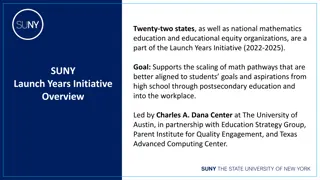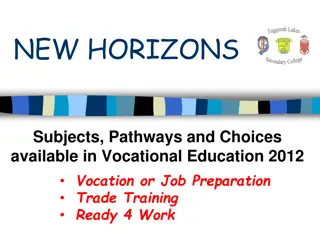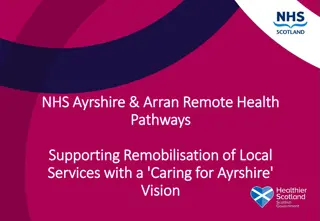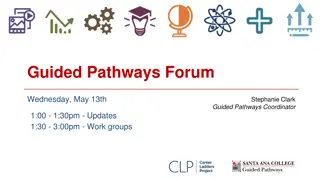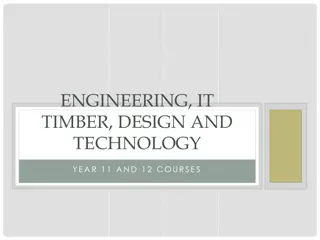
Design and Manufacture National 4 & 5 Courses Overview
Explore the Design and Manufacture National 4 & 5 courses providing an introduction to design, materials, and manufacturing processes. Develop skills in designing, prototyping, and understanding the impact of technologies on society and the environment. Discover possible career paths and further study opportunities in product design, manufacturing, engineering, and more.
Download Presentation

Please find below an Image/Link to download the presentation.
The content on the website is provided AS IS for your information and personal use only. It may not be sold, licensed, or shared on other websites without obtaining consent from the author. If you encounter any issues during the download, it is possible that the publisher has removed the file from their server.
You are allowed to download the files provided on this website for personal or commercial use, subject to the condition that they are used lawfully. All files are the property of their respective owners.
The content on the website is provided AS IS for your information and personal use only. It may not be sold, licensed, or shared on other websites without obtaining consent from the author.
E N D
Presentation Transcript
Design and Manufacture National 4 & 5 http://cdn-static.cnet.co.uk/i/c/blg/cat/cartech/dyson_cleaner.jpg
Design & Manufacture Introduction: The National 4 & 5 Design and Manufacture courses provide students with a broad practical introduction to design, and materials and manufacturing processes. They provide opportunities for them to gain skills in designing and in producing and communicating design proposals. They allow students to explore the properties and uses of materials and to make models and prototypes of products they design. The Courses provide students with skills that allow them to learn, live and work more effectively in our advancing technological society. It allows them to become not just effective contributors but informed and discerning consumers. Course Aims: The aims of the Course are to enable students to develop: skills in the design and manufacturing prototypes and products. knowledge and understanding of manufacturing processes and materials. an understanding of the impact of design and manufacturing technologies on our environment and society.
Design & Manufacture Skills, knowledge and understanding: Analysing information Applying knowledge and understanding of: - idea generation techniques - design factors - graphic techniques - modelling techniques - planning techniques - evaluation techniques - tools, materials, and processes knowledge and understanding of commercial manufacture knowledge and understanding of the impact of design and manufacturing technologies on our environment and society Problem solving Working with others Taking Initiative Planning and Organisation Creativity Innovation and Inventiveness Use of ICT, software and computer aided design and manufacture Critical thinking through exploration and discovery Searching and retrieving information Analyse, evaluate and create products Presentation skills
Design and Manufacture National 4 & 5 Possible further study and career routes : Higher (National 6) Design & Manufacture Product Design (e.g. electronics, auto-motives, communications) Interior design Manufacturing apprenticeships Design Engineering Architecture Quantity Surveying Industrial Design Skilled Trades Model Makers Graphic Designers Teaching
Graphic Communication National 4&5
Graphic Communication Introduction: The National 4 & 5 Graphic Communication courses allow learners to gain skills in reading, interpreting, and creating graphic communications. Learners will initiate, develop and communicate ideas graphically. They will develop spatial awareness and visual literacy through graphic experiences. The Course is practical, exploratory and experiential in nature. It combines elements of recognised professional standards for graphic communication partnered with graphic design creativity and visual impact. The Course allows learners to engage with technologies and it allows learners to consider the impact that graphic communication technologies have on our environment and society. Course Aims: The aims of the Course are to enable learners to: develop skills in graphic communication techniques, including the use of equipment, graphics materials and software (2D and 3D) extend and apply knowledge and understanding of graphic communication standards, protocols, and conventions where these apply develop an understanding of the impact of graphic communication technologies on our environment and society
Graphic Communication Skills, knowledge and understanding of the course Replicating shapes and forms in 2D, 3D and pictorial Initiating and producing preliminary, production and promotional graphics Initiating and producing informational graphics Developing visual literacy skills Developing spatial awareness in 2D,3D and pictorial graphic situations Using standard graphic communication equipment, software and materials effectively Knowledge of graphic communication standards, protocols and conventions Applying design skills, including creativity, when developing solutions to graphic tasks The ability to evaluate work in progress and completed graphics and applying suggestions for improvement Knowledge of a range of computer aided graphic techniques and practices Knowledge of colour, illustration and presentation techniques Knowledge and understanding of the impact of graphic communication technologies on our environment and society Problem solving Working with others Taking Initiative Planning and Organisation Creativity Innovation and Inventiveness Use of ICT, software and computer aided design Critical thinking through exploration and discovery Searching and retrieving information Presentation skills
Graphic Communication National 4 & 5 Possible further study and career routes : Higher (National 6) Graphic Communication Product Design Advertising Marketing Civil Engineering Architecture Computer Simulation Animation Print Design Design Engineering Data Analyst Teaching
Practical Woodworking National 4 & 5
Woodworking Skills Introduction: The Course is practical, exploratory and experiential in nature. It combines elements of technique and standard practice with elements of creativity. The Course provides opportunities for learners to gain a range of practical woodworking skills and to use a variety of tools, equipment and materials. It allows them to plan activities through to the completion of a finished product in wood. The Course will also give learners the opportunity to develop thinking, numeracy, employability, enterprise and citizenship skills. Course Aims: The aims of the Course are to enable learners to develop: skills in woodworking techniques skills in measuring and marking out timber sections and sheet materials safe working practices in workshop environments practical creativity and problem-solving skills knowledge of sustainability issues in a practical woodworking context.
Woodworking Skills Skills, knowledge and understanding for the course Using a range of woodworking tools, equipment and materials safely and correctly for woodworking tasks with complex features Adjusting tools where necessary, following safe working practices Reading and interpreting drawings and diagrams (working drawings) Measuring and marking out timber sections and sheet materials in preparation for cutting and shaping tasks Practical creativity in the context o woodworking tasks with complex features Using a practical problem-solving approach to woodworking tasks Applying knowledge and understanding of safe working practices in a workshop environment Knowledge and understanding of the properties and uses of a range of woodworking materials Knowledge and understanding of sustainability issues in a practical woodworking context Problem solving Working with others Taking Initiative Planning and Organisation Searching and retrieving information
Practical Woodworking National 4 & 5 Possible further study and career routes : Joinery Crafts Construction trades Manufacturing Engineering Theatre. (Stage production) Visual arts Teaching













